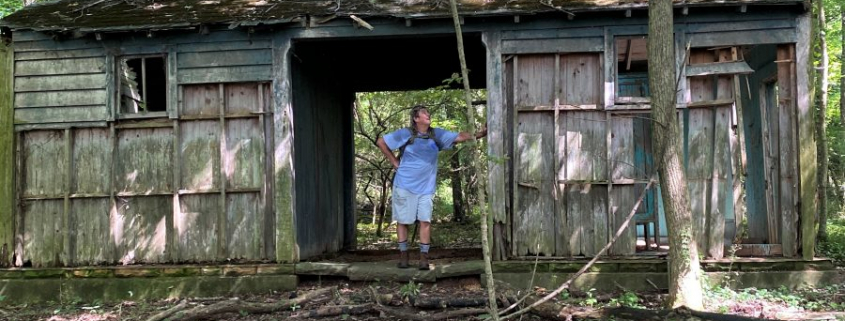Long-Abandoned Recreation Area at Joe Wheeler State Park
Straddling Twin TVA Lakes: Joe Wheeler and Wilson
Alabama’s Joe Wheeler State Park has shoreline along both the lower reaches of Joe Wheeler Lake and the upper end of Wilson Lake. July 7, 2020, Alabama State Parks Naturalist Emeritus Mike Ezell and I hiked the Park’s Multi-Use Trail along the bluffs above Wilson Lake. I focus this Post on the ruins of a long-abandoned recreation area active some 85 years ago during the heyday of Wheeler Dam construction when thousands of workers lived nearby. We walked the trail in amazement at how quickly Nature reclaims man’s intrusions and domestication. We parked near the trailhead sign (below left), hiked the sweeping 2.5-mile counter-clockwise loop taking us first through riparian forest, briefly along the lake shore (below right), then rising onto the bluffs and the abandoned recreation site. Although we walked at least a mile to the old site, I later learned that an access road at the time (1930’s) ran directly to the former concentrated-use area.
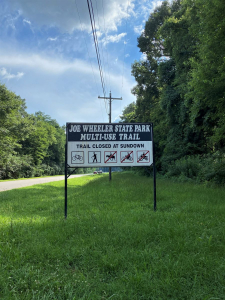
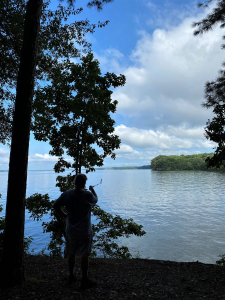
We’ve all seen photos of deep Mexican jungles draping and consuming 1,000-year-abandoned Mayan ruins. The contrast between imagining the vibrant Mayan civilization and seeing those ruins is sobering. Nature reclaims without hesitation or fail even the urban glory that the Mayans conceived, planned, constructed, and occupied… never giving thought that their days were numbered. From History.com: Most famously, the Maya of the southern lowland region reached their peak during the Classic Period of Maya civilization (A.D. 250 to 900), and built the great stone cities and monuments that have fascinated explorers and scholars of the region. That’s 650 years during the very heart of the European Middle Ages or Medieval Period. What happened to this vibrant civilization with advanced engineering, art, and architecture? Jared Diamond (Collapse: How Societies Choose to Fail or Succeed) offers deeply researched conjecture on the causes of Mayan collapse.

Among those causes that Diamond suggests is unsustainable agricultural and forestry practices leading to diminished soil fertility, erosion, disappearance of forests, and related local climate impacts (desertification)… a collection of non-sustainable practices. Add in a propensity for tribalism and intersectional warfare, and the ingredients are there for decline and collapse.
An Insert — Steve’s Firm Admonishment to Steward Our One Earth
Sound familiar? Where are we as a global society headed? Are we caring responsibly and thoughtfully for this one Earth, Our Common Home!? Are we placing ourselves at global risk of collapse, just as the Mayans did regionally on the Yucatan Peninsula in the prior millennium? With or without our Johnny-come-lately, so-called intelligent species, Nature will prevail… either with us harmoniously and respectfully learning and falling in-step, or with Nature in rebellion to our ill-conceived insistence to dominate, domesticate, and reduce. A few millennia mean nothing to the long sweep of life on Earth. If (or when) we lose, Nature will erase any evidence of our fleeting and ill-fated existence in a matter of scant millions of Earth orbits. John McPhee (Basin and Range) observed that were an adult to stand with arms extended to either side, the full reach representing the span of life on Earth (~3.8 billion years), a simple swipe of a medium-grain fingernail file across the recent end of the time scale would erase all of human history. We are everything, yet we are nothing. There is no alternative to informed and responsible Earth stewardship for our species.
Back to the Abandoned Recreation Tour
We need not visit Central America to see evidence of Nature’s inexhaustible, persistent power to overwhelm and reclaim the human-built environment. Construction crews completed Wheeler Dam in November 1936, three full years after construction began. During the peak construction period, 4,700 workers labored on the massive project (Wheeler Dam with view upstream to right; Wilson Lake to left).
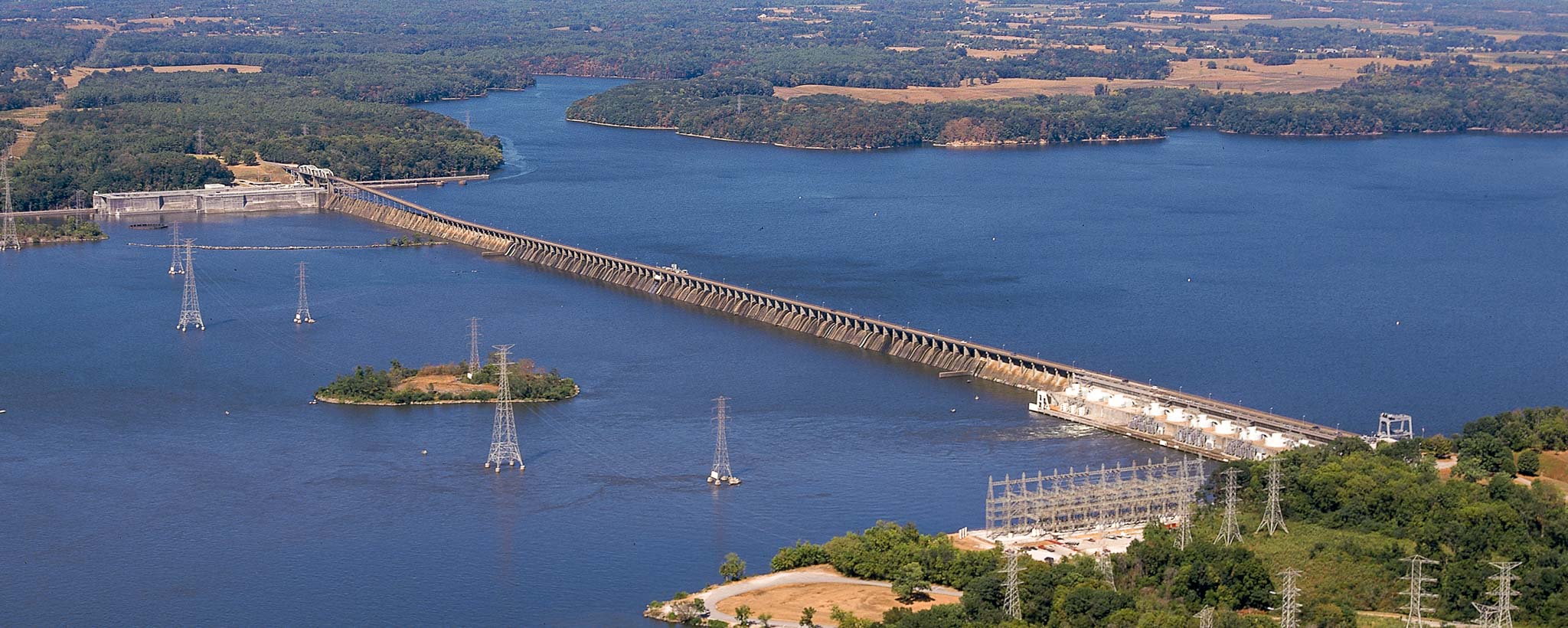
Tennessee Valley Photo Archives
The three-year construction project brought more than 10,000 residents (workers and families) to the immediate area, many living in TVA-built dormitories and prefabricated housing. The TVA also built and provided the recreation facilities that Mike and I examined along the Multi-Use Trail, now 84 years after Wheeler Dam completion, when most of the workers and their families relocated elsewhere. We presume (yes, we need to research to be certain) that the recreation area fell into dis-use about the same time, especially with the onset of WW-II. The forests across the State Park fall within the 80-90-year range, including the forest now occupying this formerly intensively used recreation area.
The TVA appears to have spared no expenses. Below left I am examining a concrete picnic table, its wooden plank benches long since decayed completely, leaving not a fiber of visible wood. The tables stand in deep forest, suggesting collapse of the vibrant human community responsible for these historical artifacts. We stood wondering how many meals families shared on these breezy open bluffs above the valley that at the time had been cleared of residents, towns, fences, outbuildings, gravesites, churches, and forests awaiting dam completion and valley inundation.
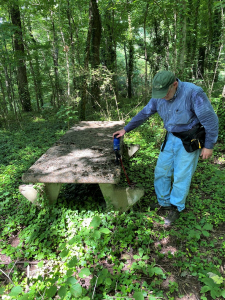
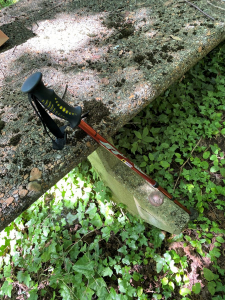
The trail passes through closed forest. A carpet of English ivy hints at the area’s past life when the European-imported landscape ivy accented the built environment, likely including some living quarters on the bluffs. The trail itself (below right) is smooth and well-maintained… easy to hike. The forest hush occasionally delivered faint, 80-year echoes of children playing and laughing, old story-telling, outdoor toasts, and a tall tale or two. We felt the spirit of kindred souls and sacred connections to the land. Imagine a young adult worker or spouse from those days being transported to accompany Mike and me on our hike. Oh, how they could have informed our journey!
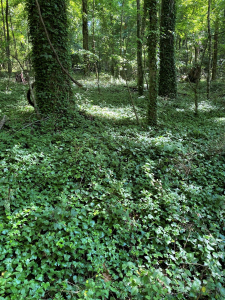
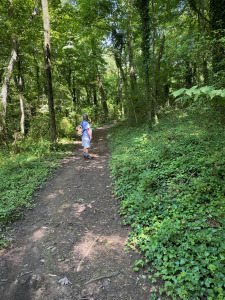
A university I know incorporates five pillars into its fundamental tenets for living and learning. One is applicable to our hike and is germane to current societal issues. I’m paraphrasing: View the future through the lens of history. We can’t understand, appreciate, or effectively live today and into tomorrow unless we know where we’ve been. Mike and I knew enough about the time-of-construction history to interpret what we saw on the ground. Sadly, we are going through a time now of societal stress and tension, a time when there is a movement to rewrite history to conform to the way we wanted (in retrospect) it to have been. We cannot change history; we can only learn from it. That is my approach to viewing the intersection of human and natural history. My Land Legacy Stories tell the tale as it happened, even if that history involved abusive agriculture, rapacious natural resource extraction, and seeming disregard for future generations. The greater sin is failing to learn from mistakes, whether or not intended. When Mike and I hiked the Park’s new Awesome Trail June 8, 2020 (https://stevejonesgbh.com/2020/07/06/joe-wheeler-state-parks-new-awesome-trail/), we found 80-90-year-old forests growing on land still erosion-scarred from careless agriculture. Again, we cannot undo the scars. we must, instead, vow to never repeat the insults.
We noted that the bluffs during dam construction had not been fully open and treeless. We found many large trees that would have even then provided comforting shade in places. This towering white oak (Quercus alba) predates the period of construction. We mused on what it had witnessed and pondered the stories it could tell.
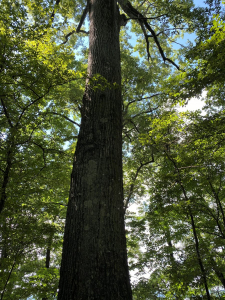
A Land of Druids, Dryads, and Wood Nymphs
We felt the presence of others as we explored in bright mid-day sun. I wondered what we might have seen and felt had we journeyed along the trail at twilight’s gloaming, accompanied by the conditions Alfred Noyes described in The Highwayman:
This is a bath house that 80 years ago stood in the open, high on the bluff. Below right Mike peers from within the dogtrot between male and female sides.
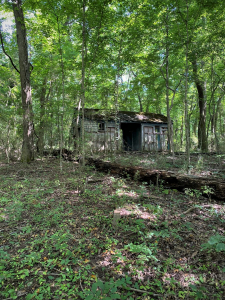
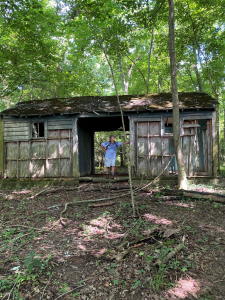
Who knows when vandals first began destroying the structure. Nature can handle what remains of the demolition project.
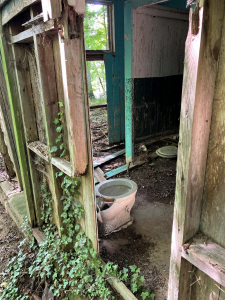
Stone masons practiced their craft with great skill. The stonework on this picnic pavilion remains strong long after the wooden upper walls and roof collapsed. Still serviceable, the foundation might one day support a new shelter.
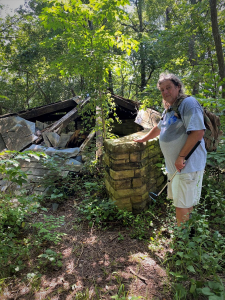
We could only speculate that these twin fireplaces stood within a large picnic shelter. Again, any trace of structure except for the stonework has succumbed to the forces of decay. The chimneys appear to emerge from the embracing forest vegetation.
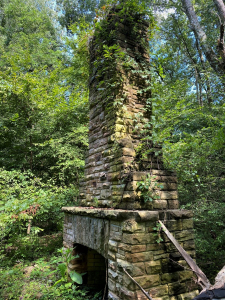
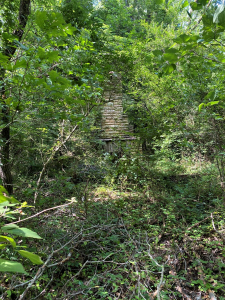
The large chestnut oak (Quercus prinus) centers the stone arc of the old observation area above Wilson Lake. On our summer visit we saw only what the full forest cover permitted, a mostly impenetrable viewshed. We decided to repeat our hike during the dormant season when vegetation relaxes its grip on the bluff, to extract a clearer image of the time-fading intersection of human and natural history.
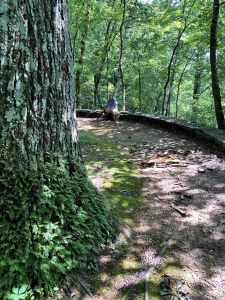
Mike and I hiked the trail filled with the wonder of Nature, fascinated by what we could read from the land, and luxuriating in the freedom of retirement. The workers who visited the recreation area some 80 years ago likely performed hard physical labor six long days a week. No freedom and flexibility of retirement for them!

Nature reveals so much to those willing to explore her mysteries, learn from past human interactions with our natural world, and apply lessons learned to our essential obligation to practice informed and responsible Earth Stewardship. Ultimately, the power of natural processes combined with unlimited time will heal any and all human-induced injury. Certainly, we cannot resuscitate species we have extinguished (including our own), yet Nature will eventually fill the resultant ecosystem voids.
Alabama State Parks Foundation
I’ll remind you that I serve on the Alabama State Parks Foundation Board, in part because of my love of Nature and in recognition for my writing many prior Posts about visiting and experiencing the Parks. I urge you to take a look at the Foundation website and consider ways you might help steward these magical places: https://asparksfoundation.org/ Perhaps you might think about supporting the Parks System education and interpretation imperative: https://asparksfoundation.org/give-today#a444d6c6-371b-47a2-97da-dd15a5b9da76
The Foundation exists for the sole purpose of providing incremental operating and capital support for enhancing our State parks.
Thoughts and Reflections
I draw three simple truths from exploring an 80-year-abandoned TVA recreation area:
We humans are everything (to ourselves), yet we are nothing.
There is no alternative to informed and responsible Earth stewardship for sustaining our species.
We cannot undo or rewrite history; we can only learn from it.
Inhale and absorb Nature’s elixir. May Nature Inspire, Inform, and Reward you!
Note: All blog post images created & photographed by Stephen B. Jones unless otherwise noted. Please circulate images with photo credit: “©2020 Steve Jones, Great Blue Heron LLC. All Rights Reserved.”
Another Note: If you came to this post via a Facebook posting or by an another route, please sign up now (no cost… no obligation) to receive my Blog Post email alerts: http://eepurl.com/cKLJdL
And a Third: I am available for Nature-Inspired Speaking, Writing, and Consulting — contact me at steve.jones.0524@gmail.com
Reminder of my Personal and Professional Purpose, Passion, and Cause
If only more of us viewed our precious environment through the filters I employ. If only my mission and vision could be multiplied untold orders of magnitude:
Mission: Employ writing and speaking to educate, inspire, and enable readers and listeners to understand, appreciate, and enjoy Nature… and accept and practice Earth Stewardship.
Vision:
- People of all ages will pay greater attention to and engage more regularly with Nature… and will accept and practice informed and responsible Earth Stewardship.
- They will see their relationship to our natural world with new eyes… and will understand more clearly their Earth home.
Tagline/Motto: Steve (Great Blue Heron) encourages and seeks a better tomorrow through Nature-Inspired Living!
Steve’s Three Books
I wrote my books Nature Based Leadership (2016), Nature-Inspired Learning and Leading (2017), and Weaned Seals and Snowy Summits: Stories of Passion for Place and Everyday Nature (2019; co-authored with Dr. Jennifer Wilhoit) to encourage all citizens to recognize and appreciate that every lesson for living, learning, serving, and leading is either written indelibly in or is powerfully inspired by Nature.
I began writing books and Posts for several reasons:
- I love hiking and exploring in Nature
- I see images I want to (and do) capture with my trusty iPhone camera
- I enjoy explaining those images — an educator at heart
- I don’t play golf!
- I actually do love writing — it’s the hobby I never needed when my career consumed me
- Judy suggested my writing is in large measure my legacy to our two kids, our five grand kids, and all the unborn generations beyond
- And finally, perhaps my books and Blogs could reach beyond family and touch a few other lives… sow some seeds for the future


All three of my books (Nature Based Leadership; Nature-Inspired Learning and Leading; Weaned Seals and Snowy Summits) present compilations of personal experiences expressing my (and co-author Dr. Wilhoit for Weaned Seals and Snowy Summits) deep passion for Nature. All three books offer observations and reflections on my relationship to the natural world… and the broader implications for society. Order any and all from your local indie bookstore, or find them on IndieBound or other online sources such as Amazon and LifeRich.

